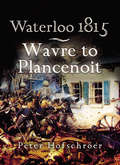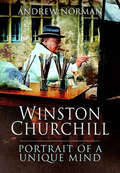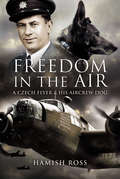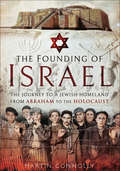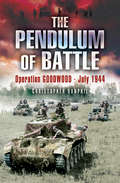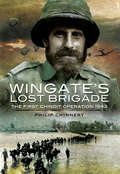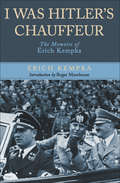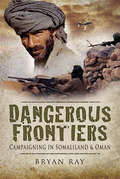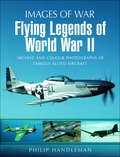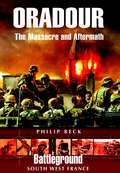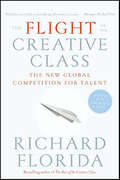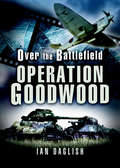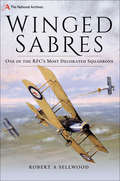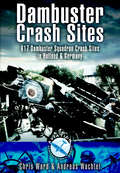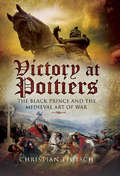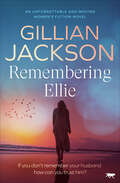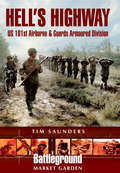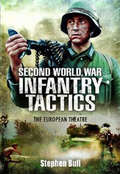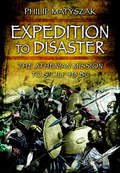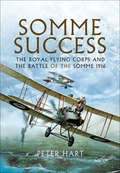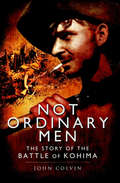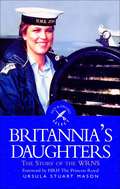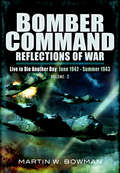- Table View
- List View
Waterloo 1815: Wavre, Plancenoit And The Race To Paris
by Peter HofschröerThe acclaimed historian sheds new light on the Battle of Waterloo and the defeat of Napoleon with a focus on the Prussian Army&’s critical contribution. Histories of the Waterloo campaign that brought an end to the Napoleonic Wars generally concentrate on the battle between the armies of Napoleon Bonaparte and the Duke of Wellington, giving Field Marshal Blücher's Prussian forces only passing attention. But in this fascinating historical analysis of the conflict, Peter Hofschröer provides a full account of the Prussians and their critical but often neglected side of the battle. Hofschröer vividly recounts the grueling Prussian advance towards the battlefield and the ferocious and decisive fight that broke out when they arrived. At every stage, he allows the reader to follow in the footsteps of the Prussian soldiers as they struggled across the Belgian countryside on that fateful day in 1815.
Winston Churchill: Portrait of an Unique Mind
by Andrew NormanSir Winston Leonard Spencer-Churchill is known chiefly for his leadership of the United Kingdom during World War Two. He served as Prime Minister from 1940 to 1945 and again from 1951 to 1955. A noted statesman and orator, Churchill was also an officer in the British Army, a historian, writer and artist. To date, he is the only British Prime Minister to have received the Nobel Prize in Literature, and the second person to be recognized as an Honorary Citizen of the United States. During his army career, Churchill saw military action in India, the Sudan and the Second Boer War. He gained fame and notoriety as a war correspondent and through contemporary books he wrote describing the campaigns. He also served briefly in the British Army on the Western Front in World War One, commanding the 6th Battalion of the Royal Scots Fusiliers. At the forefront of the political scene for almost fifty years, he held many political and cabinet positions. After losing the 1945 election, he became Leader of the Opposition. In 1951 he again became Prime Minister, before finally retiring in 1955. Upon his death, the Queen granted him the honor of a state funeral, which saw one of the largest assemblies of statesmen in the world.This unique images title contains many rare and unpublished photographs of Churchill throughout his military and political career.
James Taylor: Cut Short (Authentic Guitar-tab Editions Ser.)
by James TaylorA superstar athlete&’s inspiring autobiography—from his cricket-loving youth to the diagnosis of a career-ending heart condition and its aftermath. James Taylor was born in Burrough on the Hill, Leicestershire, in 1990. A sporting phenomenon from an early age, he chose to forge a life in cricket, establishing himself as one of the country&’s leading batsmen and an England regular. And then tragedy struck. In April 2016, a serious heart condition left Taylor fighting for his life in the changing room. Told he faced possible death if he played cricket, or exercised, ever again, James&’s bright and brilliant career was over at the age of 26. In Cut Short, Taylor reveals his route to the top. On the way, he describes how he encountered prejudice against his size and takes us through the highs and lows of his international career, including a century against the Australians and a closeup view of the unsavory nature of David Warner. With the world at his feet, Taylor reveals just what it was like to have sporting ambition snatched away right at the point of international breakthrough. He relives in breathless detail the horrific events of the day he thought he was going to die and his desolation at watching a fine sporting career torn from his grasp. At the same time he faced a battle to rebuild his life and his future, he was getting used to a body which, on several occasions, left him fearing for his existence. That James has emerged from these dark days with courage, good humor, and renewed ambition is testament to a remarkable personality.
Freedom in the Air: A Czech Flyer and his Aircrew Dog
by Hamish Ross&“Deals with a little-known aspect of the war . . . alongside the moving story of one man&’s relationship with a very special animal.&”—Sqn Ldr Paul Scott, Spirit of the Air This biography tells of the life of Václav Robert Bozděch, a Czech airman who escaped from the Nazi invasion, fought with the French and finally arrived in Britain to fly as an air-gunner with the RAF during World War II. He returned to his homeland after World War II but escaped back to the UK again when the communists gained control. Again he joined the RAF and rose to the rank of Warrant Officer. The unique part of this is that from his time in France, throughout World War II and until halfway through his second tour with the RAF, Bozděch was inseparable from his Alsatian dog, Antis, who became famous and was awarded a dog equivalent to the VC. Antis flew with his owner on many bomber raids, became the squadron mascot and was officially a serving RAF dog. He played an amazing part in the second escape from the Czech communist regime, when Bozděch was lucky to make it over the border to the US zone in Germany. &“The main hero of the book is not Bozděch himself, but his Alsatian, Antis . . . This book makes clear the extent of wartime and post-war suffering endured by Czechs and others fulfilling their roles in the overall search for freedom.&”—Aircraft Owner & Pilot &“This absorbing account of flying in WWII is based on the inseparable bond between man and dog. It is a moving story with humor and sadness. A Great Read that is Highly Recommended.&”—Firetrench
The Founding of Israel: The Journey to a Jewish Homeland from Abraham to the Holocaust
by Martin ConnollyA chronological history of the Jewish people—from the earliest attempts to establish a homeland during Biblical times to the creation of Israel. More than seventy years ago in 1948, the State of Israel came into being amidst great controversy. How did the state arise? What led to the founding of Israel? This book sets out to give a chronological journey of the Jewish people from the time Abraham came out of the land of Ur three thousand years ago, until six million of them died in the horror of the Holocaust under Hitler and his Nazi regime. It recounts the many expulsions from the land in which they lived, the suffering under Babylonians, Greeks, Persians, the destruction of their temple in Jerusalem in 70 AD, and finally, genocide and the expulsion by the Romans in 132 AD creating a diaspora across the world. The Jews would be charged with killing God and throughout the following centuries would be expelled from countries, burned alive after being locked in synagogues or at the stake, have all their property seized, and get herded into ghettoes. All of this until that fatal Holocaust, which attempted to wipe them from the face of the earth. This book recounts their story to achieve a homeland, using a wide-range of historical documents to tell the story of humiliation, suffering, poverty, and death. It tells of religious persecution that would not let them rest, and as their journey enters the twentieth century, gives a behind-the-scenes look at how governments manipulated the Middle East and exacerbated divisions.
Ask Laura: An unforgettable and moving womens fiction novel
by Gillian JacksonAn advice columnist&’s own problems reach crisis level, in this compelling blend of suspense, romance, and family drama by the author of The Dead Husband. Laura Green dispenses life advice to readers of a London magazine, but now she could use some help herself. Her teenage daughter will barely speak to her and is hiding birth control pills in her room. Her elderly mother is in a home suffering from Alzheimer&’s. And her ex is about to become a father again—while paying minimal attention to the three children he already has with Laura. When the magazine starts getting threatening letters demanding that Laura&’s column be dropped, she is helped by a young police officer but personal problems refuse to disappear. Juggling several responsibilities isn&’t easy for any divorced mom. But doing so while living in fear is much worse. Just ask Laura . . .
The Pendulum of Battle: Operation Goodwood, July 1944
by Christopher DunphieAn account of the World War II clash between British and German forces, &“the largest tank battle involving British armor ever fought&” (MQ Magazine). Operation Goodwood, the largest tank battle involving British troops ever to have taken place, has been a perpetual subject of controversy. Was it intended as a breakout from the Normandy Bridgehead, or not? Was it a success or failure? Did it lead to a severe crisis in confidence over Field Marshal Montgomery&’s leadership? This book seeks to unearth the true background, reasons, aims and achievement of Goodwood, set in the context of the overall campaign, while bringing the battle to life through personal accounts of some of those involved, both British and German.&“This well-informed account provides an excellent balance between the strategy and tactics . . . Even in a year which is seeing an unprecedented number of books on the Second World War, Pendulum of Battle deserves to be read. It is a serious, yet highly readable study of warfare and can be warmly recommended.&” —MQ Magazine
Wingate's Lost Brigade: The First Chindit Operations, 1943
by Philip D. ChinneryWith the Japanese seemingly unbeatable after their conquest of Malaya, Singapore, Thailand and much of Burma, Orde Wingates plans to conduct long range deep penetration operations behind Japanese lines in Burma were audacious to say the least. His Chindit operations (so called after Chindwin River) were hugely demanding on those taking part who suffered terrible deprivation in the harsh climatic and jungle conditions. While costly in terms of lives lost, the operations inflicted damage to the Japanese and raised Allied morale. The author has compiled a fascinating account of Wingates 77 Brigade using the personal accounts of survivors, as well as Wingates own report and post-war interrogation of Japanese generals. A remarkable story emerges of survival, courage and extreme hardship. The author evaluates the successes and failures of the mission.
I Was Hitler's Chauffeur: The Memoir of Erich Kempka
by Erich Kempka&“An insider view of Hitler&’s closest circles, providing an invaluable account of the final months of the war&” (History of War). Erich Kempka served as Adolf Hitler&’s personal driver from 1934 through to the Führer&’s dramatic suicide in 1945. His candid memoirs offer a unique eyewitness account of events leading up to and during the war, culminating in those dark final days in the Führer&’s headquarters, deep under the shattered city of Berlin. He begins by describing his duties as a member of Hitler&’s personal staff in the years preceding the war, driving the Führer throughout Germany and abroad, and accompanying him to rallies. The crux of his memoir, however, covers his life with Hitler in the Berlin Führerbunker. Crucially, Kempka witnessed Hitler&’s marriage to Eva Braun and his last dinner and personal farewell to all those present, before he and his wife committed suicide. Hitler&’s final order to Kempka was that he have ready enough petrol to burn him and his wife. Under constant Soviet artillery fire, Kempka, Linge, and others poured petrol over the bodies and burnt them. The account concludes with Kempka&’s hazardous escape out of a burning Berlin more than 800 kilometers through Allied-occupied Germany, his arrest, and interrogation before being sent to serve as a witness at Nuremburg.
Dangerous Frontiers: Campaigning in Somaliland & Oman
by Bryan RayIn Part 1 of his book the author describes his life as a young officer in the Somaliland Scouts in the (then) British Protectorate of Somaliland. At that time tribal quarrels, generally over water, were taking place in the troubled strip of country between the Protectorate and Ethiopia; the Ogaden. It was the Scouts' difficult task to keep the warring clansmen apart. It gives a vivid account of a nineteen-year-old in command of Somali troops in a fascinating and unpredictable country.The second part of the book deals with the Author's second period of service with Muslims, a quarter of a century later. This time in the Southern Province of Oman—Dhofar. Here he commanded the Northern Frontier Regiment of the Sultan's Armed Force in a limited but fierce war against Communist Insurgents. It shows how the tide was turned against a brave enemy fighting on their home ground—the savage wadis and cliffs of the jebel.Dangerous Frontiers will appeal to a wide audience, including those interesting in military and world history and in those two little known areas—the Horn of Africa and Southern Oman. In both campaigns it reflects the mutual liking and respect that the handful of British officers had for their Muslim soldiers and the soldiers for their leaders. It is written with humor and an understanding of other cultures.
Flying Legends of World War II: Archive and Colour Photos of Famous Allied Aircraft (Images of War)
by Philip HandlemanMore than thirty Allied Forces' WWII aircraft types are illustrated in many rare and previously unpublished black and white and color photographs. Each type is described giving vital data on development history, combat record, famous pilots and significant air battles. Performance, range and weapon loads are also included. The unique color photographs are from the collection of the late William B. Slate, an aviation photographer who strove to capture the thrilling perspective that can only come from close-up, in-flight vantage points from an aircraft flying in formation.
Oradour: The Massacre and Aftermath (Battleground South West France)
by Philip BeckThis WWII pictorial history illustrates a horrifying episode of destruction in Nazi-occupied France. In June of 1944, the Second SS Panzer Division Das Reich was stationed in Southern France until it was called north to help stop the Allied advance. On its way toward Normandy, Das Reich destroyed the French village of Oradour-sur-Glane and massacred its population. The brutal event ranks as one of the most notorious atrocities of the Second World War. While the scars left behind will never fully heal, many believe they should remain as a lesson to future generations. Though a new village was built nearby, President Charles de Gaulle ordered the ruins of Oradour to be preserved as a memorial to the victims. This fully illustrated volume recounts the history and legacy Oradour&’s destruction, complete with photographs of the ruins throughout
The Flight of the Creative Class: The New Global Competition for Talent
by Richard FloridaResearch–driven and clearly written, bestselling economist Richard Florida addresses the growing alarm about the exodus of high–value jobs from the USA. Today's most valued workers are what economist Richard Florida calls the Creative Class. In his bestselling The Rise of the Creative Class, Florida identified these variously skilled individuals as the source of economic revitalisation in US cities. In that book, he shows that investment in technology and a civic culture of tolerance (most often marked by the presence of a large gay community) are the key ingredients to attracting and maintaining a local creative class. In The Flight of the Creative Class, Florida expands his research to cover the global competition to attract the Creative Class. The USA once led the world in terms of creative capital. Since 2002, factors like the Bush administration's emphasis on smokestack industries, heightened security concerns after 9/11 and the growing cultural divide between conservatives and liberals have put the US at a large disadvantage. With numerous small countries, such as Ireland, New Zealand and Finland, now tapping into the enormous economic value of this class – and doing all in their power to attract these workers and build a robust economy driven by creative capital – how much further behind will USA fall?
Operation Goodwood: Operation Goodwood (Over the Battlefield)
by Ian DaglishThis ground-level WWII history describes the British armored offensive into occupied France with rare wartime photos. Military historian Ian Daglish presents an authoritatively detailed chronicle of the greatest armored battle undertaken by the British during the Second World War. After the Normandy Landings, Operation Goodwood sent British tanks south out of the Orne bridgehead. Though the operation failed to break through German defenses, it exposed critical vulnerabilities that would ultimately assist the Allies in the liberation of France. Along with the engaging and informative text, this volume includes newly discovered aerial photos taken during the fighting by the RAF. This amazing imagery makes it possible to trace the course of the battle and to track the movement of the armored regiments and troops of both sides.
Winged Sabres: One of the RFC's Most Decorated Squadrons (The\national Archives Ser.)
by Robert A. SellwoodWinged Sabres is the story of a RFC & RAF squadron flying the cumbersome FE2 from February 1916 to September 1917, and then the superlative Bristol Fighter: a two-seater fighter-reconnaissance squadron with an astonishingly high success rate.20 Squadron was possibly the highest scoring squadron of the war and one of the most highly decorated, claiming over 600 combat victories with well over 400 confirmed in RFC & RAF Communiqus. Its members won seventy gallantry decorations including a posthumous Victoria Cross, and included fliers from the U.K. and around the world. Over 40 became aces, including the American Iaccaci brothers and some Canadians and others. But with a casualty rate of around 50% including killed, wounded and POW they paid a high price.Over 15 years research has gone into this book, covering a seldom-explored aspect of WW1 in the air: the two-seater fighter-reconnaissance squadrons. 20 Squadrons motto was Facta Non Verba Deeds Not Words!
Dambuster Crash Sites: 617 Dambuster Squadron Crash Sites in Holland & Germany (Images Of War Bks.)
by Chris Ward Andreas WachtelMany of the 617 Squadron crews who took part in the famous attacks on the Mohne, Eder and Sorpe Dams and also the raids on the Dortmund-Ems Canal did not return. This book takes the reader to many of the crash sites that resulted. They include the coast off Texel, Rees, Marbeck, Emmerich, Hamm, Ostonnen, just north of the Mohne Dam, the former airfield at Gilze-Rijen in Holland and Castricum-aan-Zee, also Holland. The Dortmund-Ems Canal sites are Noordhorn, Recke, Bergeshovede, Ladbergen and Den Ham in Holland. All these sites can be visited within a weeks tour by car or public transport. The book is illustrated with then-and-now photographs of the sites, the personnel involved and the aircraft originally flown. Local places of interest are listed to allow those aficionados of this famous squadron to broaden their knowledge and also enjoy a continental break.
Victory at Poitiers: The Black Prince and the Medieval Art of War (Campaign Chronicles Ser.)
by Christian Teutsch&“Evokes the blood and mud and terror of combat . . . A good primer of the Battle of Poitiers . . . with prose that is by turns professional and passionate.&” —De Re Militari On September 13, 1356, near Poitiers in western France, the small English army of Edward the Black Prince crushed the forces of the French King Jean II in one of the most famous battles of the Hundred Years&’ War. Over the centuries, the story of this against-the-odds English victory has, along with Crcy and Agincourt, become part of the legend of medieval warfare. And yet in recent times this classic battle has received less attention than the other celebrated battles of the period. The time is ripe for a reassessment, and this is the aim of Christian Teutsch&’s thought-provoking new account. &“Teutsch describes in vivid detail the Black Prince&’s experiences that led to his horse charge across the countryside of southwest France, and the critical actions of Romorantin and Chatellerault that made Poitiers possible. His narrative culminates with the prince&’s daring ride to draw the French king Jean into battle and the drama of the combat itself. Combined with a selection of over 15 battlefield maps showing the orders of battle, this informative and highly readable account is a compulsive purchase for all with an interest in medieval history.&” —The Lance and Longbow Society
Remembering Ellie
by Gillian JacksonA woman wakes with no memory of the past ten years, in this twisting tale of mystery and mistrust by the bestselling author of The Charcoal House. When Ellie Graham wakes from a coma, she thinks she&’s eighteen years old. In reality, Ellie is twenty-eight, married, and has a baby son. She just doesn&’t remember any of it. Fearful of returning to a man she doesn&’t recognize, Ellie chooses to stay with her parents to recuperate and await the recovery of her memory. As she starts to spend time with her husband, Phil, and their son, she feels stirrings of love for her baby—and hope for renewing her attachment to her husband. But that hope is threatened when an old school friend alludes to Phil&’s controlling behavior, leaving her with dread that her marriage was far from perfect. Worse, a neighbor indicates that he wants to resume their affair—and is willing to tell Phil all about it if she refuses. Trapped and confused, can Ellie ever fully become a part of her forgotten family? Or is she stepping back into a nightmare she can&’t recall?
Hell's Highway: U.S. 101st Airborne & Guards Armoured Division (Battleground Market Garden)
by Tim SaundersThis WWII history and battleground guide offers a fascinating look at the vital and infamous stretch of road through the Netherlands. After the Allied victory at Normandy, Operation Market Garden was intended to cut a path to Germany through the Netherlands. Essential to the plan was a two-lane road that came to be known as Hell's Highway. This was the route that the British 3rd Guards Armored Division had to advance down rapidly to relieve the American Paratroopers of the 82d Airborne at Nijmegen and the British I st Airborne Division at Arnhem. Beginning with the famous capture of Joe&’s Bridge by the Irish Guards—an essential preliminary action before the start of Operation Market Garden—historian Tim Saunders guides visitors through the seizure of bridges, the liberation of small towns, and other actions undertaken by the famous Screaming Eagles. With vivid personal accounts throughout, this guide features practical visitor information about monuments and other important sites.
Second World War Infantry Tactics: The European Theatre
by Dr. Stephen BullThis wide-ranging military study examines WWII infantry tactics and operations on both sides through the battlefields of Europe. The dirty and dangerous frontlines of World War II belonged to the men who fought in the infantry. Yet the history of infantry tactics is too rarely studied and often misunderstood. Stephen Bull corrects this oversight with an in-depth account of infantry theory and combat experience, covering the British, German, and American Armies in the European theater of operations. Bull&’s close analysis of the rules of engagement, the tactical manuals, the training, and the equipment is balanced by vivid descriptions of the tactics as they were tested in action. These operational examples show how infantry tactics on all sides developed as the war progressed, and they give a telling insight into the realities of infantry warfare.
Expedition to Disaster: The Athenian Mission to Sicily 415 BC
by Philip MatyszakThis thrillingly vivid history recounts a pivotal battle of the Peloponnesian War, bringing the drama and personalities of the Sicilian Expedition to life. The Athenian expedition to conquer Sicily was one of the most significant military events of the classical period. At the time, Athens was locked in a decades-long struggle with Sparta for mastery of the Greek world. The expedition to Sicily was intended to win Athens the extra money and resources needed to crush the Spartans. With the aid of new archaeological discoveries, Expedition to Disaster reconstructs the mission, and the ensuing siege, in greater detail than ever before. The cast of characters includes Alcibiades, the flamboyant, charismatic young aristocrat; Nicias, the ageing, reluctant commander of the ill-fated expedition, and Gylippus, the grim Spartan general sent to command the defense of Syracuse. It was he who turned the tables on the Athenian invaders. They were surrounded, besieged, and forced to ask for mercy from a man who had none. Philip Matyszak's combination of thorough research and gripping narrative presents an episode of ancient history packed with colorful characters and dramatic tension.
Somme Success: The Royal Flying Corps and the Battle of The Somme 1916
by Peter HartThis history of the Royal Flying Corps during the Battle of Somme offers a comprehensive firsthand look at WWI military aviation. During the summer and fall of 1916, high above the blood-soaked trenches of the Somme, the Royal Flying Corps was engaging in one of the first great aerial battles of history. Even in those pioneering days of aerial warfare, primitive aircraft and the brave men who flew them were proving vital. Before the battle, photographic reconnaissance aircraft from both sides were desperately trying to map the opposition's deployment; artillery spotting aircraft were locating hidden targets; and bombing raids had become standard.Somme Success provides a detailed description of all facets of air operations of the period using the firsthand accounts of those who were there. It describes how the Royal Flying Corps answered the Fokker scourge in Airco DH.2 single-seater planes and, later, the ubiquitous F.E.2b two-seaters—the plane that shot down German 'Ace' Max Immelmann. Having conceded air supremacy to the Royal Flying Corps early in the Somme Offensive, the German Air Service launched an aerial counterattack during August and September. The Albatross single-seaters of the elite scout squadron proved superior to any allied aircraft. When German fighter pilot Manfred von Richthofen—the Red Baron—took to the skies, a new period of German supremacy began.
Not Ordinary Men: The Story of the Battle of Kohima (Pen And Sword Military Classics Ser. #Vol. 26)
by John ColvinHaving driven the British and Indian Forces out of Burma in 1942, General Mutaguchi, Commanding the 15th Japanese Army, was obsessed by the conquest of India. In 1944 the British 14th Army, under its commander General Slim, drew back to the Imphal Plain, before Mutaguchis impending offensive. To the north, however, the entire Japanese 31 Division had crossed the Chindwin and, on April 5, arrived at the hill-station and road junction of Kohima, cutting off Imphal except by air, from the supply point at Dimpapur.Kohima was initially manned by only 266 men of the Assam Regiment and a few hundred convalescents and administrative troops. They were joined, on April 5, by 440 men of the Fourth Battalion of the Royal West Kent Regiment, straight from the Battle of Arakan.In pouring rain, under continual bombardment, this tiny garrison held the assaults of thirteen thousand Japanese troops in hand-to-hand combat for sixteen days, an action described by Mountbatten as probably one of the greatest battles in history ... in effect the Battle of Burma, naked, unparalleled heroism, the British/Indian Thermopylae.
Britannia's Daughters: The Story of the WRNs
by Ursula Stuart MasonA comprehensive history of the Women&’s Royal Naval Service of Great Britain in the twentieth century. The Women&’s Royal Naval Service was formed in 1917 when the call was for volunteers to release a man for sea service. At the peak there was over 5,000 women serving in Britain and overseas, but efforts to maintain the service in peace time were unsuccessful. It was to be 1939, when the Second World War threatened, before the Wrens were reformed. Theirs was a different and altogether more demanding role which involved the carrying out of some highly secret and responsible duties, and many more of them served outside Britain. By 1945 there were over 75,000 officers and ratings and when the War ended, and those who wished were demobilized, a permanent Service was set up, providing a career for women alongside men of the Royal Navy. This is their story, often told in their own words, which mirrors the changing place of women in our society in a century of tremendous social progress.Features a forward by HRH The Princess Royal
Bomber Command: Live to Die Another Day June 1942–Summer 1943 (Bomber Command)
by Martin W. BowmanThis massive work provides a comprehensive insight to the experiences of Bomber Commands pilots and aircrew throughout WWII. From the early wartime years when the RAFs first attempts to avenge Germanys onslaught were bedeviled by poor navigation and inaccurate bombing, to the last winning onslaught that finally tamed Hitler in his Berlin lair, these volumes trace the true experiences of the men who flew the bombers. Hundreds of firsthand accounts are punctuated by the authors background information that puts each narrative into wartime perspective. Every aspect of Bomber Command's operational duties are covered; day and night bombing, precision low-level strikes, mass raids and operations throughout all wartime theaters. Contributions are from RAF personnel who flew the Commands different aircraft from the early Blenheims and Stirlings to the later Lancasters and Mosquitoes.Each volume is full of accounts that tell of the camaraderie amongst the crews, moments of sheer terror and the stoic humor that provided the critical bond. The five volumes of this work provide the most vivid and comprehensive work on the outstanding part played by RAF Bomber Command and their vital role in the destruction of the Third Reich.
